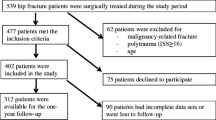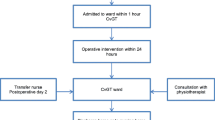Abstract
Summary
The incidence of hip fractures is increasing due to demographic transition. Data on long-term survival and influencing factors are sparse. Our prospective observational study with 395 patients shows a survival of 38% after 5 years. Significant risk factors were male gender, higher age, lower Barthel Index, lower Charlson Comorbidity Score, lower Mini-Mental State Examination, and delirium during hospitalization.
Purpose
The incidence of hip fractures is increasing due to demographic transition. Until now, they are associated with poor results and high mortality rates. Data on long-term survival and influencing factors are sparse. Therefore, a prospective observational study was conducted.
Methods
Patients ≥ 60 years with hip fracture were included in this prospective study between 2009 and 2011. Demographic parameters, as well as ASA Score, pre-fracture Barthel Index and EQ-5D, Mini-Mental State Examination, Charlson Comorbidity Score, fracture type, type of surgical treatment, place of discharge, and arising complications were registered. Outcome parameter was survival during a 5-year follow-up period.
Results
A total of 539 patients attended to our emergency room during the period of recruitment. The recruitment rate was 75%. A total of 402 patients were included; 7 were lost to follow-up, and 152 (38%) survived the study period. The mortality was more than 25% in the first year after fracture. Subsequently, it was between 7 and 9% per year. In the multivariate analysis, significant risk factors for dying were male gender (p = 0.002), higher age (p < 0.001), lower Charlson Comorbidity Score (p = 0.033), lower Barthel Index (p = 0.024), lower Mini-Mental State Examination (p = 0.002), and occurrence of delirium during hospitalization (p = 0.008).
Conclusion
Our results confirm poor results of geriatric patients after hip fracture. While early results might be influenced by optimal fracture care, long-term results seem to be determined by not changeable patient factors. Nevertheless, more than one third of surviving patients after 5 years justify the elaborate treatment algorithms for these fragile patients.


Similar content being viewed by others
References
Bundesamt S (2017) Gesundheit: Diagnosedaten der Patienten und Patientinnen in Krankenhäusern. Statistisches Bundesamt. Accessed 06.03.2018 Erschienen am 20.11.2017, Tabelle 1.1a ergänzt am 01.03.2018 (Daten je 100 000 Einwohner)
Haentjens P, Magaziner J, Colón-Emeric CS, Vanderschueren D, Milisen K, Velkeniers B, Boonen S (2010) Meta-analysis: excess mortality after hip fracture among older women and men. Ann Intern Med 152:380–390
Omsland TK, Emaus N, Tell GS, Magnus JH, Ahmed LA, Holvik K, Center J, Forsmo S, Gjesdal CG, Schei B, Vestergaard P, Eisman JA, Falch JA, Tverdal A, Søgaard AJ, Meyer HE (2014) Mortality following the first hip fracture in Norwegian women and men (1999-2008). A NOREPOS study. Bone 63:81–86
Camurcu Y, Cobden A, Sofu H, Saklavci N, Kis M (2017) What are the determinants of mortality after cemented bipolar hemiarthroplasty for unstable intertrochanteric fractures in elderly patients? J Arthroplasty 32(10):3038–3043
Frost SA, Nguyen ND, Center JR, Eisman JA, Nguyen TV (2013) Excess mortality attributable to hip-fracture: a relative survival analysis. Bone 56:23–29
Geiger F, Zimmermann-Stenzel M, Heisel C, Lehner B, Daecke W (2007) Trochanteric fractures in the elderly: the influence of primary hip arthroplasty on 1-year mortality. Arch Orthop Trauma Surg 127:959–966
Daugaard CL, Jørgensen HL, Riis T, Lauritzen JB, Duus BR, van der Mark S (2012) Is mortality after hip fracture associated with surgical delay or admission during weekends and public holidays? A retrospective study of 38,020 patients. Acta Orthop 83:609–613
Bliemel C, Sielski R, Doering B, Dodel R, Balzer-Geldsetzer M, Ruchholtz S, Buecking B (2016) Pre-fracture quality of life predicts 1-year survival in elderly patients with hip fracture-development of a new scoring system. Osteoporos Int 27:1979–1987
Folstein MF, Folstein SE, McHugh PR (1975) “Mini-mental state”. A practical method for grading the cognitive state of patients for the clinician. J Psychiatr Res 12:189–198
Lübke N, Meinck M, Von Renteln-Kruse W (2004) The Barthel Index in geriatrics. A context analysis for the Hamburg Classification Manual. Z Gerontol Geriatr 37:316–326
Charlson ME, Pompei P, Ales KL, MacKenzie CR (1987) A new method of classifying prognostic comorbidity in longitudinal studies: development and validation. J Chronic Dis 40:373–383
American society of Anaesthesiologists (2012) ASA physical status classification system. Developed By: ASA House of Delegates/Executive Committee. Last Amended: October 15, 2014 (original approval: October 15, 2014). https://www.asahq.org/standards-and-guidelines/asa-physical-status-classification-system. Accessed 7 March 2019
EQ5D - A standardised instrument for use of as a measure of health outcome- user guide (2009). https://euroqol.org/. Accessed 7 March 2019
Dindo D, Demartines N, Clavien PA (2004) Classification of surgical complications: a new proposal with evaluation in a cohort of 6336 patients and results of a survey. Ann Surg 240:205–213
Deuschland SB (2015) Sterbetafel (Periodensterbetafel): Deutschland, Jahre, Geschlecht, Vollendetes Alter. Accessed 27.3.2018
Guerra MT, Viana RD, Feil L, Feron ET, Maboni J, Vargas AS (2017) One-year mortality of elderly patients with hip fracture surgically treated at a hospital in Southern Brazil. Rev Bras Ortop 52:17–23
Lin JC, Liang WM (2017) Mortality, readmission, and reoperation after hip fracture in nonagenarians. BMC Musculoskelet Disord 18:144
Lee YK, Lee YJ, Ha YC, Koo KH (2014) Five-year relative survival of patients with osteoporotic hip fracture. J Clin Endocrinol Metab 99:97–100
Johnell O, Kanis JA, Odén A, Sernbo I, Redlund-Johnell I, Petterson C, De Laet C, Jönsson B (2004) Mortality after osteoporotic fractures. Osteoporos Int 15:38–42
Taylor CJ, Ryan R, Nichols L, Gale N, Hobbs FR, Marshall T (2017) Survival following a diagnosis of heart failure in primary care. Fam Pract 34:161–168
Sofu H, Üçpunar H, Çamurcu Y, Duman S, Konya MN, Gürsu S, Şahin V (2017) Predictive factors for early hospital readmission and 1-year mortality in elder patients following surgical treatment of a hip fracture. Ulus Travma Acil Cerrahi Derg 23:245–250
Aranguren-Ruiz MI, Acha-Arrieta MV, Casas-Fernández de Tejerina JM, Arteaga-Mazuelas M, Jarne-Betrán V, Arnáez-Solis R (2017) Risk factors for mortality after surgery of osteoporotic hip fracture in patients over 65 years of age. Rev Esp Cir Ortop Traumatol 61:185–192
Dubljanin-Raspopović E, Marković-Denić L, Marinković J, Nedeljković U, Bumbaširević M (2013) Does early functional outcome predict 1-year mortality in elderly patients with hip fracture? Clin Orthop Relat Res 471:2703–2710
Eschbach DA, Oberkircher L, Bliemel C, Mohr J, Ruchholtz S, Buecking B (2013) Increased age is not associated with higher incidence of complications, longer stay in acute care hospital and in hospital mortality in geriatric hip fracture patients. Maturitas 74:185–189
Joseph B, Pandit V, Zangbar B, Kulvatunyou N, Hashmi A, Green DJ, O’Keeffe T, Tang A, Vercruysse G, Fain MJ, Friese RS, Rhee P (2014) Superiority of frailty over age in predicting outcomes among geriatric trauma patients: a prospective analysis. JAMA Surg 149:766–772
Tosteson AN, Gottlieb DJ, Radley DC, Fisher ES, Melton LJ (2007) Excess mortality following hip fracture: the role of underlying health status. Osteoporos Int 18:1463–1472
González Quevedo D, Mariño IT, Sánchez Siles JM, Escribano ER, Granero Molina EJ, Enrique DB, Smoljanović T, Pareja FV (2017) Patient survival and surgical re-intervention predictors for intracapsular hip fractures. Injury 48:1831–1836
Kilci O, Un C, Sacan O, Gamli M, Baskan S, Baydar M, Ozkurt B (2016) Postoperative mortality after hip fracture surgery: a 3 years follow up. PLoS One 11:e0162097
Noro A, Aro S (1996) Health-related quality of life among the least dependent institutional elderly compared with the non-institutional elderly population. Qual Life Res 5:355–366
Caldararo MD, Stein DE, Poggio JL (2016) Nursing home status is an independent risk factor for adverse 30-day postoperative outcomes after common, nonemergent inpatient procedures. Am J Surg 212:202–208
Arshi A, Lai WC, Chen JB, Bukata SV, Stavrakis AI, Zeegen EN (2018) Predictors and sequelae of postoperative delirium in geriatric hip fracture patients. Geriatr Orthop Surg Rehabil 9:2151459318814823
Moskowitz EE, Overbey DM, Jones TS, Jones EL, Arcomano TR, Moore JT, Robinson TN (2017) Post-operative delirium is associated with increased 5-year mortality. Am J Surg 214:1036–1038
Dresing PDK (2015) Leitlinien Unfallchirurgie – überarbeitete Leitlinie Registernummer 012 – 002 ICD-10 S72.10 Pertrochantäre Oberschenkelfraktur (ICD-10 S72.10). Deutsche Gesellschaft für Unfallchirurgie (DGU). http://www.awmf.org/leitlinien/detail/ll/012-002.html. Accessed 7 March 2019
Bohm E, Loucks L, Wittmeier K, Lix LM, Oppenheimer L (2015) Reduced time to surgery improves mortality and length of stay following hip fracture: results from an intervention study in a Canadian health authority. Can J Surg 58:257–263
Simunovic N, Devereaux PJ, Sprague S, Guyatt GH, Schemitsch E, Debeer J, Bhandari M (2010) Effect of early surgery after hip fracture on mortality and complications: systematic review and meta-analysis. CMAJ 182:1609–1616
Ribeiro TA, Premaor MO, Larangeira JA, Brito LG, Luft M, Guterres LW, Monticielo OA (2014) Predictors of hip fracture mortality at a general hospital in South Brazil: an unacceptable surgical delay. Clinics (Sao Paulo) 69:253–258
Pereira SR, Puts MT, Portela MC, Sayeg MA (2010) The impact of pre-fracture and hip fracture characteristics on mortality in older persons in Brazil. Clin Orthop Relat Res 468:1869–1883
Author information
Authors and Affiliations
Corresponding author
Ethics declarations
The study has been approved by the Ethics committee of the University of Marburg. Informed consent was obtained from all individual participants included in this study.
Conflict of interest
None.
Additional information
Publisher’s note
Springer Nature remains neutral with regard to jurisdictional claims in published maps and institutional affiliations.
Rights and permissions
About this article
Cite this article
Knauf, T., Bücking, B., Bargello, M. et al. Predictors of long-term survival after hip fractures?—5-year results of a prospective study in Germany. Arch Osteoporos 14, 40 (2019). https://doi.org/10.1007/s11657-019-0586-1
Received:
Accepted:
Published:
DOI: https://doi.org/10.1007/s11657-019-0586-1




